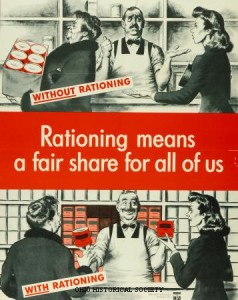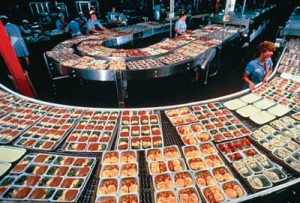 I’ve been wanting to write about this for a while, now, but you know how sometimes… you just don’t know where to begin? Something is so screwed up from all sides, that there’s no possible way to make sense of it from it’s head or it’s heels?
I’ve been wanting to write about this for a while, now, but you know how sometimes… you just don’t know where to begin? Something is so screwed up from all sides, that there’s no possible way to make sense of it from it’s head or it’s heels?
Yeah, that’s kind of this processed food thing. And I know, in advance, that this is long. Frustratingly long, even. I’m breaking it up into bits, though, so don’t worry if you can’t take it all in at once.
What are processed foods? Allow me to shed some light.
A “processed food,” in general, is something that has had to endure a process to make it what it is before it is turned over to you. Almost everything that comes in a box… is processed. Almost everything that comes in a zip-sealed bag… is processed. Almost everything that comes from a big giant brand or huge corporation or massive factory plant somewhere… is processed. Almost everything that you purchase from a grocery store… is processed.
I mean, that includes a lot – that’s all the aisles in the grocery store! You’d have to scale the perimeter of the store to avoid that, right?
Let’s look at the history of food in this country over the past one hundred or so years.
 Once upon a time, before food was big industry (meaning: before processed foods) and we were dealing with the fear of famine, people were much smaller. Being overweight was a rich person’s dilemma. Why? Because you have to ingest an AWFUL LOT of whole foods (as in, not processed) on a regular basis to develop and maintain an overweight physique in that day. So being overweight simply didn’t make financial sense. Things like bread, pies, cookies, cakes… they were rare – couldn’t always buy them at the store, so you had to make them at home. Highly unlikely that you could or would be able to bake sweets every single day for your pleasure.
Once upon a time, before food was big industry (meaning: before processed foods) and we were dealing with the fear of famine, people were much smaller. Being overweight was a rich person’s dilemma. Why? Because you have to ingest an AWFUL LOT of whole foods (as in, not processed) on a regular basis to develop and maintain an overweight physique in that day. So being overweight simply didn’t make financial sense. Things like bread, pies, cookies, cakes… they were rare – couldn’t always buy them at the store, so you had to make them at home. Highly unlikely that you could or would be able to bake sweets every single day for your pleasure.

To sum it up, food wasn’t presumed to be plentiful, and it caused people to skimp, penny pinch, and exercise portion control.
Now, in comes the push toward larger food distributors – less focus on local, more focus on “getting big.” “Get big or get out,” I believe was the actual line. The US Gov’t honestly feared that they wouldn’t be able to feed everyone without food production going factory, and took every effort they could to try to get it there. With food production being taken to the factories, we were separated more from how our food was made. The further the process was taken from us, the less oversight we had in regards to what was in it. We used to have the milkman, right? You made arrangements with a local farm to have your milk delivered to your door, right? Now, if you drink milk, you’re buying a gallon that comes from a farm that you have no knowledge of. You’re buying from a brand.
I’m a small business owner, so while I could interject right here about what it does to our local communities to not be able to buy our food locally and keep our money in our communities… I won’t. Just know that I could.

The 1938 Food, Drug and Cosmetic Act imposed strict rules requiring that the word “imitation” appear on any food product that was, well, an imitation … [And] the food industry [argued over the word], strenuously for decades, and in 1973 it finally succeeded in getting the imitation rule tossed out, a little-notice but momentous step that helped speed America down the path of nutritionism.
… The American Heart Association, eager to get Americans off saturated fats and onto vegetable oils (including hydrogenated vegetable oils), was actively encouraging the food industry to “modify” various foods to get the saturated fats and cholesterol out of them, and in the early seventies the association urged that “any existing and regulatory barriers to the marketing of such foods be removed.”
And so they were when, in 1973, the FDA (not, note, the Congress that wrote the law) simply repealed the 1938 rule concerning imitation foods. … The revised imitation rule held that as long as an imitation product was not “nutritionally inferior” to the natural food it sought to impersonate—as long as it had the same quantities of recongized nutrients—the imitation could be marketed without using the dreaded “i” word. — In Defense of Food: An Eater’s Manifesto
Families who survived the rationing and the famine were happy about this! No more struggling, breaking their backs to stretch food. They could eat like the rich folks! They could also gain weight like ’em, too. Alas, the way men and women were employed in this era, they weren’t granted the same amount of time for leisurely activity like the rich. In other words, we were eating “like the rich,” but not burning the weight off like ’em. This part of the story, can be evidenced by Katharine Flegel’s study of weight gain from the sixties to the present. This New Yorker article summarizes it briefly:
In the early nineteen-nineties, a researcher at the C.D.C. named Katherine Flegal was reviewing the results of the survey then under way when she came across figures that seemed incredible. According to the first National Health study, which was done in the early nineteen-sixties, 24.3 per cent of American adults were overweight—roughly defined as having a body-mass index greater than twenty-seven. (The metrics are slightly different for men and women; by the study’s definition, a woman who is five feet tall would count as overweight if she was more than a hundred and forty pounds, and a man who is six feet tall if he weighed more than two hundred and four pounds.) By the time of the second survey, conducted in the early nineteen-seventies, the proportion of overweight adults had increased by three-quarters of a per cent, to twenty-five per cent, and, by the third survey, in the late seventies, it had edged up to 25.4 per cent. The results that Flegal found so surprising came from the fourth survey. During the nineteen-eighties, the American gut, instead of expanding very gradually, had ballooned: 33.3 per cent of adults now qualified as overweight. Flegal began asking around at professional meetings. Had other researchers noticed a change in Americans’ waistlines? They had not. This left her feeling even more perplexed. She knew that errors could have sneaked into the data in a variety of ways, so she and her colleagues checked and rechecked the figures. There was no problem that they could identify. Finally, in 1994, they published their findings in the Journal of the American Medical Association. In just ten years, they showed, Americans had collectively gained more than a billion pounds. “If this was about tuberculosis, it would be called an epidemic,” another researcher wrote in an editorial accompanying the report.
Food was becoming way more accessible to us. I do want to go back to the point about the FDA’s law about imitation substances, though. It does a lot more to the food industry than you think it does. Take a loaf of bread, for example. Bread has maybe five ingredients in it – flour, water, sugar, salt, and yeast – but if you look on the label for the bread in your house right now? You see what – hyphenated chemicals. The food industry now has the ability to put anything in your food, so long as it is not deficient in the nutrients that science recognizes are valuable… in comparison to the food it imitates. Remember this part. No, really – remember this part.
So, if the foods aren’t nutritionally deficient, why is this a problem?
Well, how much credit do you give food science? The rule is simply that the foods cannot be deficient in nutrients that science recognizes as valuable. What about what science hasn’t spotted yet? What about all these hyphenated chemicals that science hasn’t identified (or is prevented from identifying) as harmful to our health?
And before you call me a conspiracy theorist, consider this: it took science decades to recognize that trans-fats – once a massive part of margarine and other major foods – were hazardous to our health. Believe it or not, the government still allows trans-fats in foods, and actually allows food manufacturers to lie about how much trans-fats are in their foods. (More on that later.)

That’s not the conspiracy theorist in me. That’s just smart business on their part… regardless of what it does to the consumer. Keep the consumer far enough away from the research, and they’ll never know the downfall of buying my product. It just happens that way.
So since this is all cyclical, let’s go back to that availability of food thing. Now, all this food (food, mind you, that seeks to NOT be nutritionally deficient although it admits that it is) is available to our families. We, knowing what it’s like to have to worry about food not being available, begin to indulge. Factories – and factory jobs – are springing up because industries are blossoming. Longer work hours, both adults in the household are now working, and all this super convenient food at hand. We’re eating what we can, when we can, and eating a lot of it… since we’re enjoying the ability to eat at our discretion, not at the discretion of a ration.
Keep in mind, also, at this time… a new generation of children are being born under this new understanding of food. Family tradition might lend to certain dishes being made a certain way, but lots of dishes are being replaced by the magic elixir in the box. Some of us have that Grandma who insists on cooking everything from scratch. We tend to write her off as crazy or paranoid because “Times have changed” and “No one has time for all that cooking,” or maybe because “This is the [insert decade]s, Nana, we don’t live in the kitchen the way you used to!” Things that are all true, but come with consequences.
I asked you, dear reader, to keep in mind the point I made earlier about hyphenated chemical ingredients in our food, right? I hope you did. The interesting loophole in the FDA’s policy about imitation foods is that there’s very little limit to what can now be put INTO food. That’s an important point.

Can you do that with your home made cooking? I doubt it.
Here’s another question: What do you think they’re putting in these processed foods to ward off insects and rodents?
Last question: Do you think it’s a good idea to ingest the same chemicals that are put in food… food that flies don’t even want? The same chemicals that prevent flies from desiring our food, are the same chemicals we’re ingesting when we eat this stuff anyway. How healthy can that be? Nothing in the world can debunk what feels like logic to me.

So here we are, living in the new millennium. For breakfast, we’re eating cereal. For lunch, we give our kids lunchables. For dinner, we heat up a pot pie. (If you want a laugh, look at the ingredients list on the back of any of those.) For a drink, we have a capri sun or a coke. Instead of nutrient-filled calorie-light whole foods, we’re now indulging in calorie-heavy nutrient-light foods that’ve been mainly cooked FOR us. When we take in foods, our bodies are expecting a certain amount of nutrients and vitamins. If our body doesn’t get what it’s looking for fast enough, what happens? It compels you to eat more! Yes! Have you ever inhaled half a bag of wafers, only to be hungry again moments later? All that work your body put in to digest this vitamin-free food, only to find that there are no vitamins in it? Yes, it’s going to tell you to try again and eat something else.
The problem for many of us, is that because it’s so much easier and quicker to grab another processed food item instead of cooking.. we try to fix the problem with something that’d only make it worse. All the while scarfing down the calories, forgetting all the nutrients, and packing on the pounds while we’re at it. The convenience, the fact that very few of us know how some foods are cooked, let alone what the foods SHOULD consist of, has allowed us to eat much more with much less effort. Is that a bad thing? If you know how to moderate yourself, of course not. Many of us, apparently, don’t.
Having said all that (2600 words, and STILL not a record for me), I have to say this. I know we all lead busy lives. If you managed to read all of this in one sitting, I give you kudos – I couldn’t even write it all in one sitting. We have to scale back in a major way if we want to be healthy. In writing this, I’ve decided to break this up into a series, continuing it on with how I managed to wean my family off of processed foods and what it’s taught me about how my body interacts with food, and how it wants to interact with food. Big difference between the two.
So, keep your eyes peeled for the breakdown of this topic, and the continuation… that I’m opting to call Food 101. I look forward to your thoughts below!

20 comments
Wow! What a great article, sis. I thought I knew everything when it came to processed foods but I actually learned a great deal. Passing this on to friends and family members.
I’m exhausted after reading all that… LOL! Just kidding! The article was VERY informative. While we know a few of those things about the food we eat, we never really look at in the light in which you’ve presented it. In such a fast paced world, where we don’t have lots of time, it’s easy to use processed foods as part of your daily meals.
Part of the deception with processed foods is the use of the words “natural,” “all natural” or “100% natural.” Take Campbell’s Harvest Select Soup, for example. I’ve seen commercials for it, stating that it’s “100% natural.” However, when you read the ingredients, there are a few fleeting ingredients that make you go “Hmmm…. How ‘natural’ is that?” As most people don’t read labels and/or don’t take the time to learn or dig deeper in terms of nutrition, they see “100% Natural” and think they are getting something “healthy.” It may not be as bad as other products, but it’s still processed.
I can’t wait to read more from you on the subject. As with everything, I’m sure processed foods are OK in moderation, but this just solidifies the fact that I’m gonna have to kick old school and set Sunday aside for cooking. I’m talking about baking bread, making meals from scratch, etc.
This post was a lot to digest, but really worth reading. I think being more educated to the money game behind food, could save some of us. So many of us are not knowledgeable at all about the food we eat. Thanks for sharing definitely I know I learned some new stuff. Way tot teach an OG new tricks!!
-OG
Excellent article. I’m adamant about eating unprocessed foods. This will be the first year my family is planting a sizeable veggie garden. We’re all committed to making better food choices.
Excellent article, though I still plan to see the movie Food,Inc.(I think its called), your article has given much of the info that I’m sure is in that movie. I, too have made the decision to become a much more conscientious consumer. I’ve shopped at health food stores for years-in addition to the local food marts and thought I knew much. You’ve shown me that I still have a bit to learn. Thanks;a very informative read on basically eating clean.
Yeah, Food, Inc. is the name of the movie. It DOES cover a lot of this, but it leaves some of it out (and understandably so, LOL.) It’s definitely a good movie, well worth the watch!
@Gee, I’m excited for you! I’m considering planting a little garden, as well – give my daughter something nice and small to care for. We’ll see how that goes, lol.
@Tracy and OG… I’own wanna hear it – y’all only had to read it. I had to read the research aaaand write it! LOL! I’m glad that you enjoyed the post, though. I’ll soon be discussing some of the marketing mishaps in food labeling… “natural” is a huge one.
Girl, let me tell ya…I was a vegetarian for years and though I was pretty healthy. I’d have been MUCH better off if I’d known the issue with processed foods. I mean, truly which is better for you? Faux meat with lots of names you can’t pronounce or organic/natural meat comprised of the same elements basically as you or I. It would have helped to know that too much of ANYthing especially any processed thing isn’t good. Sooooo, with that said I eat a little of this and a little of that these days…mostly sticking with what I make or what comes directly from a plant of some kind. Kudos!!
I really liked this topic.
I remember when the only processed food my grandmother would have in her house were baking staples(flours, oils, spices, etc) and boxed cereals. We had drop biscuits and cornbread for bread up until her 70’s when the cooking became too much for her. And mixing dough for rolls at 5am was no joke! I hated visiting her in the summers ’caused we weeded and canned whatever she grew ot bought, and also cleaned many a chicken she got minus the head from a local farm by the dozen.
Gleaners and Forgotten Harvest have a weekly food distribution at my church. When I help out, they always pack me a box of food. I usually wind up giving most of it away to neighbors that are worst off than me simply because I try my best to stay away from processed foods. My neighbor told me that they are suffering in this economy (grown children having to move back home with children of their own)and appreciate whatever I can share. It’s a question of them not having enough food versus processed “healthy” food. I don’t drink orange juice “from concentrate” or any bottled juices. I’d rather eat the fruit anyway. I don’t do breaded anything, or sugar substitutes. It’s funny how long it took me to get used to the taste of homemade salad dressing, as opposed to bottled stuff.
This year, I’m using the neighborhood kids to help me plant my garden and do yardwork in exchange for veggie plants and flowers. They bring me a pot and their labor, and an hour or so later we both have things planted. They are actually learning about eating fresh fruits and vegetables DAILY from school: Thanks Mrs Obama! I had to go back to the Farmer’s market to buy another flat of mixed vegetables today! We talked about using composted manure, and soapy water/companion plants instead of bug sprays. I told them that we could have a “healthy” bbq at the end of the summer with grilled vegetables (from our gardens), fruit, and some type of healthy protein. Are there any healthy hotdogs/sausages out there? If not I guess I could do chicken…
Teaching the kids about healthy home grown fruits and veggies? I love everything about this!
Gosh, my commenters are so amazing. Talk about a movement. 🙂
Wow! Great article. I read it in one sitting, and like others, learned a great deal. I need to continue to educate myself and go back to cooking my meals. I used to cook and rarely eat out and now the pendulum has shifted. Time to move it back and go back to cooking and making things from scratch! Thanks for the nudge!
Wow, how did I miss this! GREAT read!
A lot of info that I was not aware of. Thanks for this article!
Great information. I am a serial cereal eater. LOL! I know it is necessary for me to stop with the processed foods. But, it is so hard. How can you go from eating processed foods to…regular food so easily? Especially if you are a picky eater like me?
OMG!! Awesome information! It was like the cliff notes to Food Inc documentary and all the other ones about food. As a public health professional, I think it is sad how we have a nation on processed foods, but wonder why there is an obesity epidemic! SMH!
How long & how often do you suggest one should work out? Also, have you ever tried calorie counting? Someone earlier mentioned Zumba, something I recently started, but I haven’t found a
devicethat tracks cals lost. tha), but lost, is challenging.
Check here.
This is a fantastic article. Absolutely I agree 100% with everything you’ve said. I’m in the culinary industry myself, and struggling with the menu I prepare for my job and the sort of food I’d prefer to eat at home. It has been a long journey for me, but I know for certain that when I took a big step back from processed foods, things got a lot easier for me in many ways. Keep up the fantastic work. This site’s a real gem in the food/fitness realm.
This was a great read, if your into being educated the length shouldn’t be a problem which in this case it wasnt. My husband was telling me about this and I just wasn’t on it like that until recently its being talked about a lot more and to come across this article was confirmaton that things need to change in my kitchen. As hard as its going to be to wean ourselves off this type of living. I am trully inspired to do so. I’m not a chief or anything but i’m willing to learn some new tricks. And also i’m a US Vet/Contractor in Afghan, how do you try and eat healthy when there is not to much you can do to change the food thats being served to you? Well I know for future references I will be making an effort to change my eating habits. Thanks
I mean, if you’re a contractor, I’d question if you’re better suited to request healthier, cleaner, fresher fare than if you were in service to our military, or do I have that wrong?
I wonder if anyone else has any tips or suggestions that may help you get closer. I’m really at a loss, since I don’t have any experience with the military like that at all.
Also, *salutes*
I have recently decided to do some research in order to become healthier and leaner for myself and my family. I knew that dieting wouldn’t work for me. I want a plan that would be more than a fad, but a lifestyle change for me and my family. That is how I came across the concept of Clean Eating and your website.
Talk about a crash course in Food History! LOL. Thank you for all the time that you put into this article.
As I am still in a transitioning phase. This article did give me some perspective of what exactly is in those boxes. I really don’t want to put something in my and my families’ body that a fly wouldn’t touch.
I look forward to embarking on this journey. Thank you for such a in-depth, and entertaining resource!
Comments are closed.